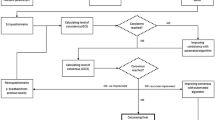Abstract
Background
This study was conducted to validate the role of virtual reality computer simulation as an objective method for assessing laparoscopic technical skills. The authors aimed to investigate whether performance in the operating room, assessed using a modified Objective Structured Assessment of Technical Skill (OSATS), correlated with the performance parameters registered by a virtual reality laparoscopic trainer (LapSim).
Methods
The study enrolled 10 surgical residents (3 females) with a median of 5.5 years (range, 2–6 years) since graduation who had similar limited experience in laparoscopic surgery (median, 5; range, 1–16 laparoscopic cholecystectomies). All the participants performed three repetitions of seven basic skills tasks on the LapSim laparoscopic trainer and one laparoscopic cholecystectomy in the operating room. The operating room procedure was video recorded and blindly assessed by two independent observers using a modified OSATS rating scale. Assessment in the operating room was based on three parameters: time used, error score, and economy of motion score. During the tasks on the LapSim, time, error (tissue damage and millimeters of tissue damage [tasks 2–6], error score [incomplete target areas, badly placed clips, and dropped clips [task 7]), and economy of movement parameters (path length and angular path) were registered. The correlation between time, economy, and error parameters during the simulated tasks and the operating room procedure was statistically assessed using Spearman’s test.
Results
Significant correlations were demonstrated between the time used to complete the operating room procedure and time used for task 7 (r s = 0.74; p = 0.015). The error score demonstrated during the laparoscopic cholecystectomy correlated well with the tissue damage in three of the seven tasks (p < 0.05), the millimeters of tissue damage during two of the tasks, and the error score in task 7 (r s = 0.67; p = 0.034). Furthermore, statistically significant correlations were observed between the economy of motion score from the operative procedure and LapSim’s economy parameters (path length and angular path in six of the tasks) (p < 0.05).
Conclusions
The current study demonstrated significant correlations between operative performance in the operating room (assessed using a well-validated rating scale) and psychomotor performance in virtual environment assessed by a computer simulator. This provides strong evidence for the validity of the simulator system as an objective tool for assessing laparoscopic skills. Virtual reality simulation can be used in practice to assess technical skills relevant for minimally invasive surgery.

Similar content being viewed by others
References
Grantcharov TP (2006) Virtual reality simulation in teaching and assessment of laparoscopic surgical skills. Eur Clin Obstet Gynecol 2:197–200
Gallagher AG, McClure N, McGuigan J, Ritchie K, Sheehy NP (1998) An ergonomic analysis of the fulcrum effect in the acquisition of endoscopic skills. Endoscopy 30:617–620
Hanna GB, Shimi SM, Cuschieri A (1998) Task performance in endoscopic surgery is influenced by location of the image display. Ann Surg 227:481–484
Hanna GB, Shimi SM, Cuschieri A (1998) Randomized study of influence of two-dimensional versus three-dimensional imaging on performance of laparoscopic cholecystectomy. Lancet 351:248–251
Hanna GB, Cuschieri A (1999) Influence of the optical axis-to-target view angle on endoscopic task performance. Surg Endosc 13:371–375
Aggarwal R, Moorthy K, Darzi A (2004) Laparoscopic skills training and assessment. BJS 91:1549–1558
Deziel DJ, Milikan KW, Economou SG, Doolas A, Ko ST, Airan MC (1993) Complications of laparoscopic cholecystectomy: a national survey of 4,292 hospitals and an analysis of 77,604 cases. Am J Surg 165:9–14
Eriksen JR, Grantcharov TP (2005) Objective assessment of laparoscopic skills using a virtual reality stimulator. Surg Endosc 19:1216–1219
Schijven MP, Jakimowicz J (2003) Construct validity: experts and novices performing on the Xitact LS500 laparoscopy simulator. Surg Endosc 17:803–810
Schijven MP, Jakimowicz J (2004) The learning curve on the Xitact LS 500 laparoscopy simulator: profiles of performance. Surg Endosc 18:121–127
Grantcharov TP, Bardram L, Funch-Jensen P, Rosenberg J (2003) Learning curves and impact of previous operative experience on performance on a virtual reality simulator to test laparoscopic surgical skills. Am J Surg 185:146–149
Gallagher AG, Lederman AB, McGlade K, Satava RM, Smith CD (2004) Discriminative validity of the minimally invasive surgical trainer-virtual reality (MIST-VR) using criteria levels based on expert performance. Surg Endosc 18:660–665
Reznick R, Regehr G, MacRae H, Martin J, McCulloch W (1997) Testing technical skill via an innovative “bench station” examination. Am J Surg 173:226–230
Grantcharov TP, Kristiansen VB, Bendix J, Bardram L, Rosenberg J, Funch-Jensen P (2004) Randomized clinical trial of virtual reality simulation for laparoscopic skills training. Br J Surg 91:146–150
Carter FJ, Schijven MP, Aggarwal R, Grantcharov T, Francis NK, Hanna GB, Jakimowicz JJ, Work Group for Evaluation and Implementation of Simulators and Skills Training Programmes (2005) Consensus guidelines for validation of virtual reality surgical simulators. Surg Endosc 19:1523–1532
Author information
Authors and Affiliations
Corresponding author
Rights and permissions
About this article
Cite this article
Kundhal, P.S., Grantcharov, T.P. Psychomotor performance measured in a virtual environment correlates with technical skills in the operating room. Surg Endosc 23, 645–649 (2009). https://doi.org/10.1007/s00464-008-0043-5
Received:
Revised:
Accepted:
Published:
Issue Date:
DOI: https://doi.org/10.1007/s00464-008-0043-5




